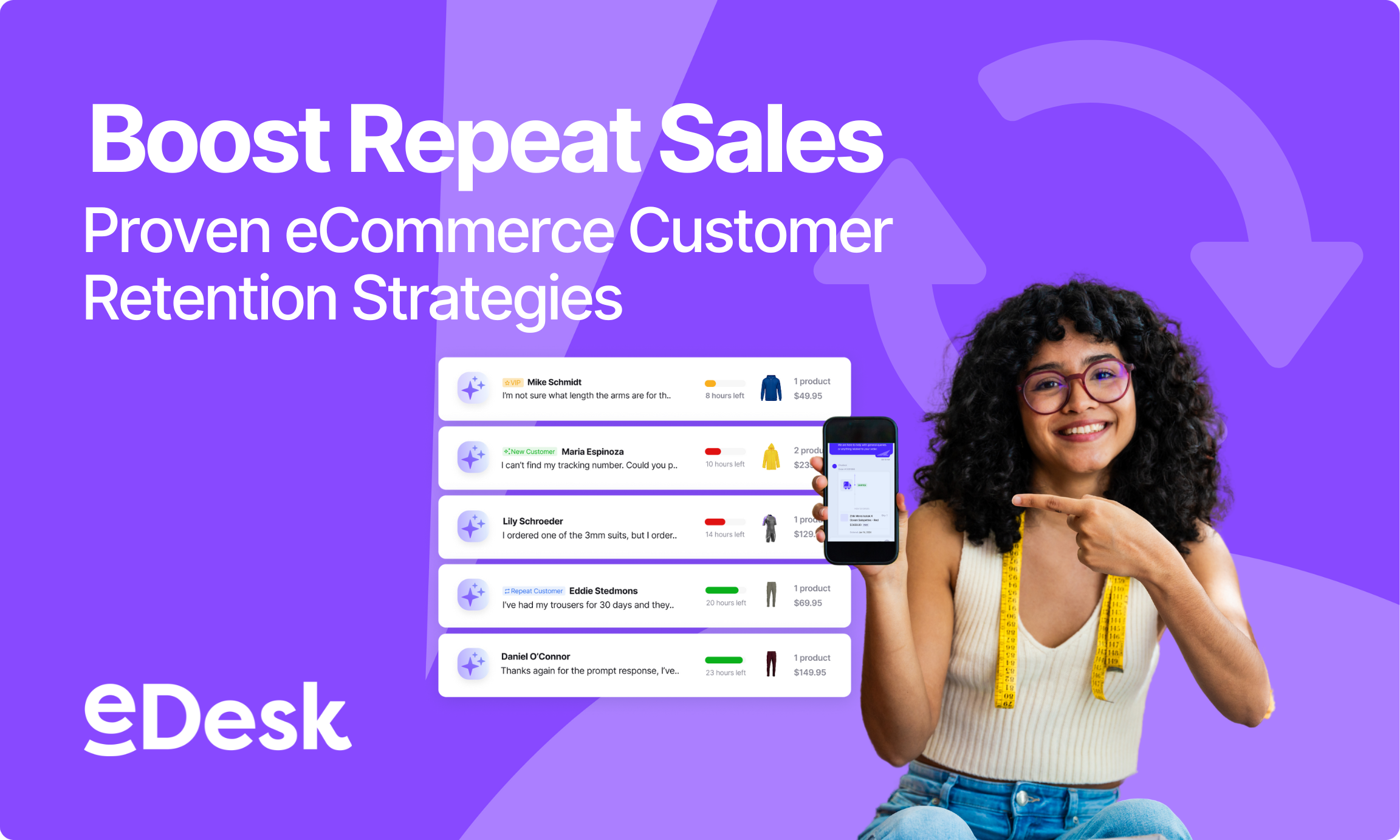Retaining customers is more cost-effective and profitable than acquiring new ones. That’s an undeniable fact. But with the average eCommerce customer retention rate hovering around 38%, online businesses have to implement strategic measures to keep customers returning. (That, too, is a fact).
To give you a hand with this, we’ve put together a guide that gives you actionable strategies to enhance eCommerce customer retention and build lasting customer relationships. Because we’re helpful like that (you can thank us later).
OK, let’s get going:
1. Simplify the Purchasing Process
A seamless purchasing experience is crucial for customer satisfaction and repeat business. Encouraging customer registration allows for:
- Order tracking
Customers appreciate the ability to monitor the progress of their deliveries in real time, reducing anxiety and increasing trust in your brand. - Faster checkouts
Registered users can save their details for future purchases, making the checkout process quicker and more convenient, which is key for reducing cart abandonment. - Personalized offers
With access to customer data, you can tailor promotions and recommendations to individual preferences, increasing the likelihood of repeat purchases. - 24/7 access to order history
Online shoppers don’t wait until ‘business hours’ to shop for the products they want and need. So it goes without saying that your customer service and support team should be within close reach when someone is ready to reach out. Customers should not be expected to wait to get the help they need.
2. Implement Customer Loyalty Programs
Effective eCommerce customer loyalty programs incentivize repeat purchases and foster brand allegiance. For instance, Newegg’s EggPoints Program rewards customers for their purchases, encouraging continued engagement. Similarly, Sephora’s Beauty Insider program offers tiered rewards, which enhance customer experience and loyalty.
eDesk’s platform can integrate with loyalty programs, enabling personalized communication and tracking of customer interactions to enhance loyalty initiatives.
3. Enhance the Post-Purchase Experience
The customer journey doesn’t end at checkout. A robust post-purchase strategy can significantly impact eCommerce customer retention. Key elements include:
- Timely and informative order confirmations
- Proactive shipping updates
- Personalized follow-up emails
- Easy access to support channels
eDesk’s multi-channel communication tools ensure customers receive consistent and personalized updates, enhancing their post-purchase experience.
4. Utilize Personalized Communication
Personalization is a powerful tool in retaining customers. Studies show that 80% of customers are more likely to stay loyal to brands offering personalized experiences. eDesk’s AI-driven platform enables businesses to:
- Address customers by name
- Recommend products based on purchase history
- Send tailored promotions
By delivering relevant content, businesses can foster stronger customer relationships and encourage repeat purchases.
5. Establish Feedback Loops
Gathering and acting on customer feedback demonstrates a commitment to continuous improvement. Implementing feedback loops allows businesses to:
- Identify areas for enhancement
- Address customer concerns promptly
- Adapt offerings to meet customer needs
eDesk’s integrated feedback tools facilitate the collection and analysis of customer insights, enabling businesses to make informed decisions that boost retention.
6. Offer Subscription Models
Subscription models provide convenience and predictability for customers, leading to increased retention. By offering products or services on a recurring basis, businesses can:
- Establish consistent revenue streams
- Build long-term customer relationships
- Enhance customer lifetime value
eDesk supports subscription-based businesses by managing customer interactions and ensuring timely communication, critical for maintaining subscriber satisfaction.
7. Provide Proactive Customer Support
Proactive support anticipates customer needs and addresses issues before they escalate. This approach includes:
- Monitoring customer behavior for signs of dissatisfaction
- Reaching out with solutions or assistance proactively
- Offering self-service options through a comprehensive knowledge base
eDesk’s AI-powered helpdesk enables businesses to deliver proactive support, reducing churn and enhancing the overall customer experience.
8. Maximize Customer Lifetime Value (CLV)
Increasing customer lifetime value in eCommerce is essential for sustainable growth. Strategies to achieve this include:
- Cross-selling and upselling relevant products
- Providing exceptional customer service
- Personalizing the shopping experience
eDesk’s platform offers insights into customer behavior, enabling businesses to tailor their strategies effectively and maximize CLV.
9. Deliver outstanding customer service
Strive to create the best experience for each and every customer. People want excellent products and services paired with a personalized buying experience. Focus less on doing more transactions and more on providing your customers with exceptional service.
Juggling a high volume of customer queries from multiple sales platforms is daunting if you don’t have effective tools in place to help you get the job done. An e-commerce help desk consolidates queries from all your sales channels into a central shared resource, so all the data you need to resolve tickets quickly is at your fingertips.
10. Engage with your customers post-purchase
Social media
Don’t just go social …be social. It’s rare to come across a company that does any of the following on their social networks:
- Answers questions
- Asks questions
- Comes across as personable and willing to engage with the “average customer”
- Acknowledges and responds to positive and negative feedback and comments
Yes, we know this all sounds like social media 101, but you’d be surprised…
Every consumer wants to do business with a company they can trust. Being open, friendly, and approachable on social media shows your brand is not robotic. Social media is more than just a way of saying, “Hi, I’m here. Buy from me now.” It’s a great way to learn more about your customers and understand what they really want.
11. Establish clear methods of communication
The fastest way to upset your customers is to challenge them in a guessing game when they’re looking to get in touch. If it can’t easily be found on your website or in their email receipts, it puts up a red flag. And nobody likes a red flag. Assume they haven’t bookmarked the emails you sent, and make sure your contact information is on every page of your website.
Most customers dread calling customer service. So don’t make them do it if you possibly can. Simple as that. Offer the fastest and most convenient method of communication (such as online chat or email) as your first point of contact. Fast service is expected. But truthfully, call volume, length and a prompt response are all secondary to making sure the customer’s issue was resolved the first time your team responds.
Don’t lose your customers by making them wait. eDesk enables you to send automated, personalized responses to customer queries, especially during peak times, after hours and holidays.
Real-World Application: eDesk in ActionWaveSpas, a family-run eCommerce business, leveraged eDesk’s AI chatbot to handle over 70% of customer queries instantly. This implementation led to improved response times and increased customer satisfaction, demonstrating the impact of efficient support on eCommerce customer retention. |
Get Started
Implementing these strategies can significantly enhance your eCommerce customer retention, leading to increased profitability and business growth. eDesk’s comprehensive suite of tools supports businesses in delivering exceptional customer experiences, fostering loyalty, and driving repeat sales.
Explore how eDesk can transform your customer retention strategy: Book a demo today.




